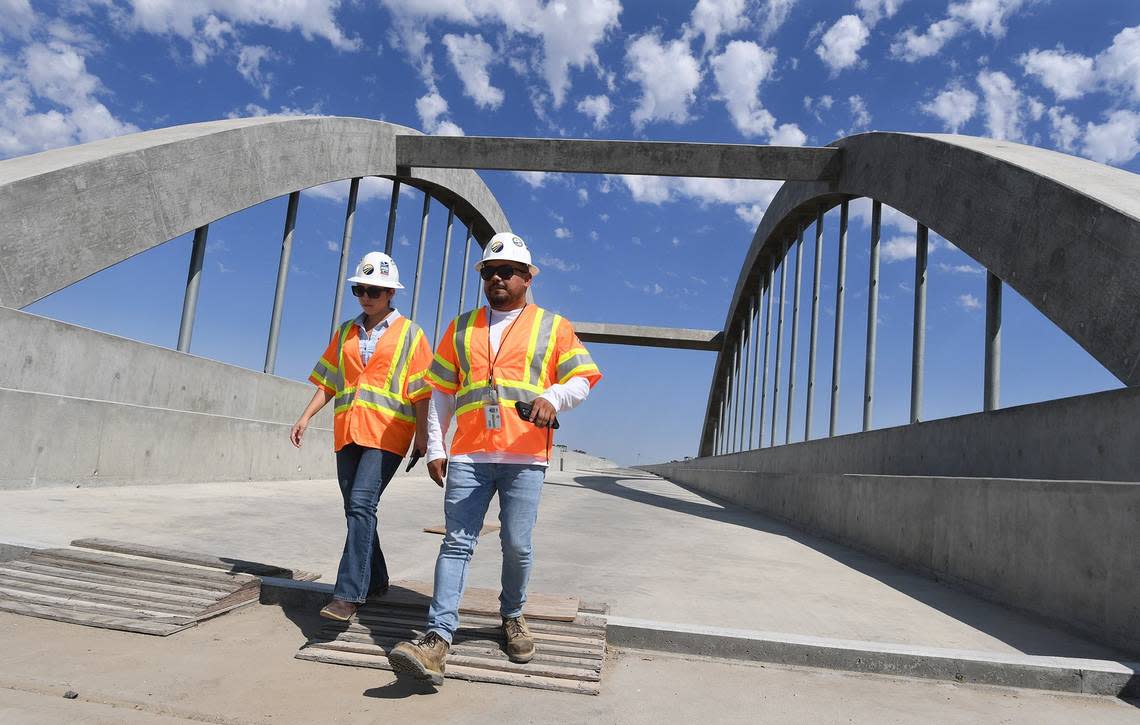Feds skip over California bullet train’s $1.2 billion grants request. What happens now?
California’s controversial bullet-train project has been passed over by the federal government in its efforts to secure about $1.2 billion to continue construction in the central San Joaquin Valley.
The California High-Speed Rail Authority had applied last year for about $1.2 billion in competitive grants from two different programs under the 2021 Bipartisan Infrastructure Law. But the authority struck out on both, according to grant announcements made last month by the U.S. Department of Transportation.
“We were disappointed not to receive a grant in this particular round,” Brian Annis, the rail agency’s chief financial officer, told The Fresno Bee in a telephone interview.
The missed grants were part of the federal Multimodal Project Disciplinary Grant program, nicknamed MEGA. But Annis noted that the agency had previously received money, although in smaller amounts, from other federal grant programs.
Construction is currently underway on about 119 miles of the planned high-speed rail route from north of Madera to northwest of Bakersfield. The MEGA applications sought more than $1.2 billion to:
▪ Add a second set of tracks to the current 119-mile construction route.
▪ Complete advanced design work to extend the route northward into downtown Merced and southeast into downtown Bakersfield, providing a 171-mile line of track and systems that would be the state’s first operational segment for high-speed trains.
▪ Buy six high-speed train sets for initial testing and future passenger service between Merced and Bakersfield.
▪ Build two initial passenger stations in Fresno and Hanford.
▪ Begin route design for other high-speed rail segments across the state for which environmental clearances have been approved or are nearing approval, including San Francisco-San Jose; San Jose-Merced; Bakersfield-Palmdale; and Burbank-Los Angeles.
“While it is disappointing not to receive a MEGA grant this round, only nine recipients nationwide were awarded funding out of the hundreds that applied,” a spokesperson for the rail authority said. “The authority remains optimistic that our strong partnership with the Biden-Harris administration will result in continued joint investment from the Infrastructure Investment and Jobs Act, from which the authority has already received grant funding. …”
Annis said the first round of MEGA grants awarded nationwide amounted to about $1.2 billion, “so we asked for more than they awarded in total.”
“California as a whole did not do too well in MEGA, just a single award of $30 million to a project in Santa Cruz,” he added.
What’s next?
While the California High-Speed Rail Authority missed out on the first big grants for which it applied, “we’re not slowing down work,” Annis said. “We’re continuing full steam ahead for the Merced-to-Bakersfield project.”
But, “we do need federal funds to complete the full scope for the Merced-Bakersfield project,” he added. “Getting (federal money) does definitely accelerate our project. If we don’t, at some point it’s going to slow us down.”
The next opportunity for the rail authority to seek federal money is in April, the deadline set by the U.S. Department of Transportation for applications to the Federal-State Partnership for Intercity Passenger Rail. That five-year program has about $36 billion available, of which two-thirds is earmarked for the Northeast Corridor from New England to Washington, D.C. The remaining $12 billion will be up for grabs in an application process in which the California High-Speed Rail Authority must compete against other passenger rail projects across the country.
The Federal Railroad Administration announced last week that it has added almost $2.3 billion to the pot, bringing the total available in the first year of funding to more than $4.5 billion outside of the Northeast Corridor, according to the Federal Register.
More rounds of the MEGA grants are also coming up over the next few years, and Annis said California will put in applications for those as well.
“There is no doubt that we want federal money, that we need federal money,” Annis said. When Proposition 1A, a $9.9 billion bond act for high-speed rail, was approved by California voters in 2008, state rail leaders expected the federal government to pitch in between one-third and one-half of the total project cost for a full 520-mile system linking San Francisco and Los Angeles via Fresno and the San Joaquin Valley.
A moving price tag
But cost estimates have fluctuated wildly since California has received about $3.5 billion in federal railroad and economic stimulus funds in 2010 and 2011. A statewide system at one time expected to cost somewhere around $43 billion; that later ballooned to almost $100 billion before the state rail agency sought ways to use “value engineering” to bring the costs back down.
The most recent cost estimate for the planned Merced-Bakersfield operational segment is about $24 billion, according to the California High-Speed Rail Authority’s 2022 business plan sent to the state Legislature last year.
“We do need federal funds to complete the full scope for the Merced-Bakersfield project,” Annis said. “It’s very important that we win some big awards here in the upcoming grant cycles.”
Construction beyond the San Joaquin Valley – east to San Jose and San Francisco and south to Palmdale, Burbank, Los Angeles and Anaheim – is very much a wild card not only in terms of scheduling and when future money might become available, but also cost.
Depending on the complexity of construction and uncertainty of such costs as buying property for right of way, tunneling through the Coast Range toward San Jose and the Tehachapi and San Gabriel mountain ranges toward Los Angeles, the agency’s 2022 business plan estimated the price tag for a full San Francisco-to-Los Angeles/Anaheim system range from a low of $72.3 billion to as much as $105.1 billion.

